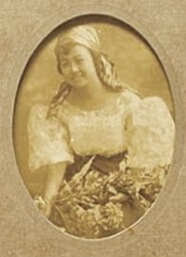Atang de la Rama
Atang de la Rama | |
|---|---|
 Atang de la Rama from a 1919 performance invitation of "Dalagang Bukid" at the Teatro Zorilla | |
| Born | Honorata de la Rama January 11, 1902 |
| Died | July 11, 1991 (aged 89) Manila, Philippines |
| Alma mater | Centro Escolar de Señoritas (pharmacy) |
| Occupation(s) | Singer Theater actress |
| Years active | 1919–1956 |
| Spouse | Amado V. Hernandez[1] |
| Awards | |
Honorata de la Rama-Hernandez (January 11, 1902 – July 11, 1991), commonly known as Atang de la Rama, was a singer and bodabil performer who became the first Filipina film actress.[2]
Biography
[edit]
Atang de la Rama was born in Pandacan, Manila on January 11, 1902. By the age of 7, she was already starring in Spanish zarzuelas such as Mascota, Sueño de un Vals, and Marina. At the age of 15, she starred in the sarsuela Dalagang Bukid, where she became known for singing the song "Nabasag na Banga".[3]
During the American occupation of the Philippines, Atang de la Rama fought for the dominance of the kundiman, an important Philippine folk song, and the sarsuela, which is a musical play that focused on contemporary Filipino issues such as usury, cockfighting, and colonial mentality.[4]
Generations of Filipino artists and audiences consider Atang de la Rama's vocal and acting talents as responsible for much of the success of original Filipino sarsuelas like Dalagang Bukid, and dramas like Veronidia.[4] She has also been a theatrical producer, writer and talent manager. She was the producer and the writer of plays such as Anak ni Eva and Bulaklak ng Kabundukan. For her achievements and contributions to the art form, she was hailed Queen of the Kundiman and of the Sarsuela in 1979, at the age of 74.[3]
Atang believed that art should be for everyone; not only did she perform in major Manila theaters such as the Teatro Libertad and the Teatro Zorilla, but also in cockpits and open plazas in Luzon, the Visayas, and Mindanao. She also made an effort to bring the kundiman and sarsuela to the indigenous peoples of the Philippine such as the Igorots, the Aetas, and the Mangyans. She was also at the forefront of introducing Filipino culture to foreign audiences. At the height of her career, she sang kundimans and other Filipino songs in concerts in such cities as Hawaii, San Francisco, Los Angeles, New York City, Hong Kong, Shanghai, and Tokyo.
On May 8, 1987, "for her sincere devotion to original Filipino theater and music, her outstanding artistry as singer, and as sarsuela actress-playwright-producer, her tireless efforts to bring her art to all sectors of Filipino society and to the world," President Corazon C. Aquino proclaimed Atang de la Rama a National Artist of the Philippines for Theater and Music.[5]
De la Rama died on July 11, 1991. She was married to National Artist for Literature, Amado V. Hernandez.
Notes
[edit]- ^ Degroot, Veronique; Klokke, Marijke J. (May 1, 2013). Materializing Southeast Asia's Past: Selected Papers from the 12th International Conference of the European Association of Southeast Asian Archaeologists. NUS Press. ISBN 978-9971-69-655-9. Retrieved November 8, 2021.
- ^ Atang de la Rama. p. 97-109. Nicanor G. Tiongson. The National Artists of the Philippines. Cultural Center of the Philippines. and National Commission for Culture and the Arts. Anvil Publishing.2004. ISBN 971-27-0783-0
- ^ a b Honorata "Atang" dela Rama Archived October 10, 2006, at the Wayback Machine
- ^ a b Cultural Center of the Philippines. (2002). Lagi Kitang Naaalala. Manila: Cultural Center of the Philippines
- ^ National Commission for Culture and the Arts. (n.d.). National Artists of the Philippines. Manila: National Commission for Culture and the Arts.

